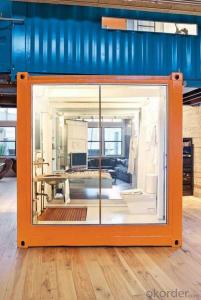Eco Friendly Prefab Container House Windproof For Labor Dormitory
- Loading Port:
- Tianjin
- Payment Terms:
- TT OR LC
- Min Order Qty:
- -
- Supply Capability:
- 500 Sets set/month
OKorder Service Pledge
OKorder Financial Service
You Might Also Like
Modern movable vacation glass container house
This prefab container Modern movable vacation glass container house is jointed by our basic product called Flat-packed container house. It is widely used foroffice, accommodation and commercial kiosk.
ProductFeatures:

Dimension(mm)&Weight(kg)
Type | External | Internal | Weight (kg) | |||||
Length | Width | Height (package) | Height (assembled) | Length | Width | Height | ||
20’ | 6055 | 2435 | 648/864 | 2591/2790 | 5860 | 2240 | 2500 | from 1850 |
Floor
Steel frame | - made from cold rolled, welded steel profiles, 4 mm thick |
- 4 corner casts, welded | |
- 2 fork lift pockets (except 30’) - distance 1200mm (internal clearance of fork lift pockets: 240×80 mm) | |
- steel cross members, thickness=2mm | |
Insulation | - 100 mm thick Rock Wool |
Subfloor | - 0.5mm thick, galvanized steel sheet |
Floor | - 18mm plywood board |
- 1.8mm PVC floor - flammability class B1 - hardly combustible - smoke density class Q1 - low smoke emission - wear resistance factor: T level |

Insulation
Rockwool | - density:120kg/m3 |
- flammability class A- non combustible - smoke density class Q1 - low smoke emissio n | |
- certificated: CE & GL | |
NeoporR | - density:18kg/m3 |
- flammability class B1- non combustible - smoke density class Q1 - low smoke emission | |
- certificated: CE & GL |


Coatings(Optional)
Deco Coating | Special coating can be applied on top of sandwich wall panel and make the external wall surface looks like plastering finishes or timber finishes. That makes the container house cozy and less industry look. |

Packaging & Shipping
From ourfactory to overseas client, there are two ways to delivery the houses. If yourport can accept SOC (Shipper’s Owned Container), 4 standard cabins can bepacked as a 20ftcontainer and shipped naked. If can not, 7standard cabins can be loaded into one40ft HC.


From thedealer’s workshop to the client’s place, it can be delivered by 6m long truck after assembly. The width and height are within traffic limitation.

Our Services

Wecould provide deisgn, manufacture, logistic and on-site instruction services.
Company Information



- Q: Can container houses be built with multiple stories?
- Indeed, it is possible to construct container houses with multiple stories. Although shipping containers are typically employed for single-story buildings, they can also be stacked or merged to form multi-story container houses. This not only enhances flexibility but also maximizes the utilization of limited space. Nonetheless, it is crucial to take into account structural integrity and proper engineering in the design of multi-story container houses in order to guarantee the safety and stability of the edifice. Moreover, additional adjustments and reinforcements may be necessary to comply with building codes and regulations.
- Q: Can container houses be designed with a large outdoor patio?
- Yes, container houses can be designed with a large outdoor patio. By utilizing multiple containers or adding extensions to the structure, a spacious outdoor patio area can be created. The containers can be modified, stacked, or arranged in a way that allows for an expansive patio space, accommodating various outdoor activities and functions. Additionally, creative design solutions such as retractable roofs or folding wall systems can provide flexibility and maximize the use of the outdoor space in container houses.
- Q: Are container houses prone to pests and insects?
- Container houses are not inherently more prone to pests and insects than traditional houses. However, like any other type of dwelling, container houses can be susceptible to infestations if proper preventive measures are not taken. Regular maintenance, proper sealing, and implementing pest control strategies can effectively minimize the risk of pests and insects in container homes.
- Q: What are the classification of container moving houses and containers?
- the second category is a new type of box-type mobile room, the third category is removable box-
- Q: Can container houses be designed with water-saving fixtures?
- Yes, container houses can definitely be designed with water-saving fixtures. These fixtures, including low-flow toilets, faucets, and showers, can be installed in container homes to reduce water consumption and promote sustainability. Additionally, rainwater collection systems can be incorporated into the design to further conserve water resources.
- Q: Can container houses be designed with a home library or study area?
- Yes, container houses can definitely be designed with a home library or study area. Container houses are known for their versatility and adaptability, allowing for various customization options to meet different needs and preferences. With proper planning and design, a container house can easily accommodate a home library or study area. One approach to incorporating a library or study area in a container house is by utilizing the vertical space. Containers can be stacked or connected horizontally and vertically to create multiple levels, providing ample space for a dedicated library or study area. Shelves, bookcases, and study desks can be installed along the walls or built into the container structure, maximizing the available space. Another option is to create a separate room or partition within the container house specifically for the library or study area. This can be achieved by using dividing walls or screens to create a distinct space within the container. This approach allows for more privacy and a dedicated environment for concentration and learning. Additionally, container houses can be designed with large windows or skylights to maximize natural light, creating a bright and inviting atmosphere for reading and studying. Adequate lighting fixtures and electrical outlets can also be installed to ensure proper illumination and functionality in the library or study area. Ultimately, the design possibilities for incorporating a home library or study area in a container house are limitless. With careful planning and creative solutions, container houses can be customized to meet individual needs and preferences, including the addition of a functional and cozy space for reading, learning, and studying.
- Q: Can container houses be built in urban environments?
- Container houses are indeed suitable for urban environments, and they have become increasingly popular in cities due to their affordability, sustainability, and flexibility. These houses are constructed by repurposing shipping containers, which are readily available and cost-effective. They can be easily customized and designed to integrate seamlessly into the existing urban landscape. In urban areas, container houses have numerous advantages. Firstly, they are an environmentally friendly choice as they repurpose containers that would otherwise go to waste. Additionally, container houses can be built using energy-efficient materials and incorporate sustainable features like solar panels and rainwater harvesting systems, which are highly desirable for eco-conscious urban residents. Moreover, container houses are highly adaptable and can be tailored to fit various urban spaces. They can be stacked or combined to create multi-story structures, maximizing the use of limited land. This versatility also makes container houses suitable for urban infill projects, where vacant lots or underutilized spaces can be transformed into affordable and visually appealing housing options. Furthermore, container houses can be aesthetically pleasing and blend harmoniously with urban neighborhoods. With thoughtful design and architectural elements, container houses can seamlessly coexist with traditional houses and buildings. Many urban areas have even embraced container house developments as a means to rejuvenate neighborhoods and provide affordable housing solutions. However, it is important to note that building container houses in urban environments may require compliance with local building codes and regulations. These regulations ensure the safety, structural integrity, and well-being of residents. It is crucial to collaborate with experienced professionals who are knowledgeable about container house construction and familiar with local regulations. In conclusion, container houses can be successfully constructed in urban environments, offering affordability, sustainability, and flexibility. With careful planning, design, and adherence to local regulations, container houses can contribute to the creation of vibrant and affordable urban communities.
- Q: Can container houses be designed with a wine cellar or wine room?
- Yes, container houses can be designed with a wine cellar or wine room. With proper planning and design, containers can be modified to accommodate temperature and humidity control, ensuring optimal conditions for storing wine. The size and layout of the container can be adjusted to create a dedicated space for wine storage, complete with appropriate insulation, ventilation, and shelving systems.
- Q: Are container houses suitable for individuals who enjoy outdoor activities?
- Yes, container houses can be suitable for individuals who enjoy outdoor activities. Container houses are known for their versatility and portability, making them ideal for those who love spending time outdoors. These houses can be easily transported to different locations, allowing individuals to explore and engage in various outdoor activities in different environments. Container houses can also be customized to include features that cater to outdoor enthusiasts. For example, they can be designed with large windows or glass doors to provide stunning views of the surrounding nature. Additionally, container houses can be equipped with outdoor amenities such as decks, patios, or rooftop terraces, providing ample space for individuals to relax and enjoy outdoor activities. Furthermore, container houses are often built with materials that are durable and weather-resistant, making them suitable for various outdoor environments. They can withstand harsh weather conditions, ensuring that individuals can comfortably enjoy their outdoor adventures without worrying about the structural integrity of their homes. Moreover, container houses can be an eco-friendly option for individuals who value sustainable living and outdoor activities. Many container houses are constructed using recycled materials, reducing the carbon footprint and promoting environmental conservation. These houses can also be designed to be energy-efficient, utilizing renewable energy sources such as solar panels or rainwater harvesting systems. In conclusion, container houses can be a great choice for individuals who enjoy outdoor activities. They offer flexibility, customization options, and durability, making them suitable for adventurous individuals who want to incorporate their love for the outdoors into their living spaces.
- Q: How do container houses handle natural light?
- There are multiple ways in which container houses manage natural light. To begin with, they can utilize large windows or glass doors to allow abundant sunlight into the space. These windows are strategically positioned to optimize the amount of natural light that enters the house. Furthermore, skylights can be installed on the roof of container houses to bring in even more natural light. Another technique employed by container houses to handle natural light is the use of light-colored interior finishes and materials. Light-colored walls, ceilings, and floors reflect and enhance natural light, resulting in a brighter and more spacious atmosphere. Lastly, container houses can integrate various shading devices like blinds or curtains to regulate the amount of sunlight that enters the house and prevent overheating during hot summer months. All in all, container houses prioritize the utilization of natural light to create a welcoming and well-lit living environment.
Send your message to us
Eco Friendly Prefab Container House Windproof For Labor Dormitory
- Loading Port:
- Tianjin
- Payment Terms:
- TT OR LC
- Min Order Qty:
- -
- Supply Capability:
- 500 Sets set/month
OKorder Service Pledge
OKorder Financial Service
Similar products
Hot products
Hot Searches
Related keywords























